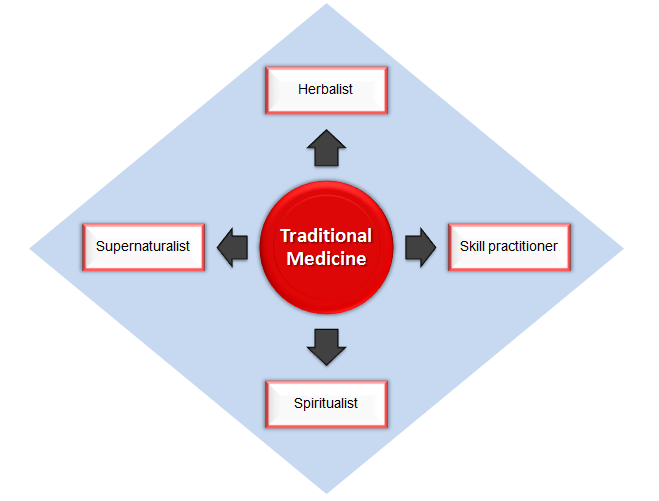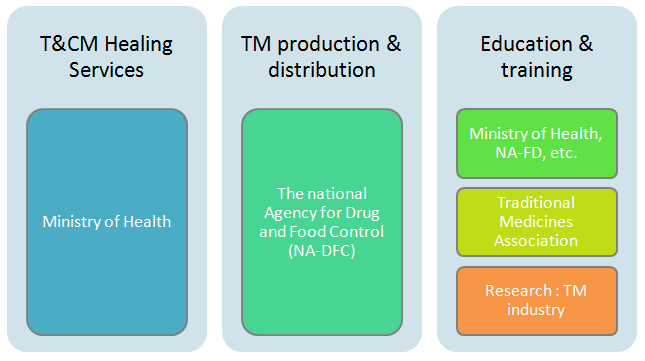Chronological development
- Traditional medical system in Indonesia has many influences from Hinduism, Buddhism and Islam. The oldest and most popular among the traditional medicine practices are herbal medicine ‘Jamu’. It is said that jamu originated from Java.
- Jamu has been used by the Indonesians predated back to the 15th century during Mataram period where historical relics showed pictures of medicinal plants in use on some temples such as Borobudur, Prambanan and Panataran. [11]
- In 1775, medicinal plants (jamu) were studied by the modern science, followed by publication of a book called Herbia Ambionesia by Rumphius. [12]
- Colonization of the Dutch in the 19th century brought modern education to Indonesia.
Current practice
Modern (conventional) medicine remains as the mainstream tradition of healthcare in the country. However, traditional medicinal treatments continue to be practiced by numerous healers and practitioners all over the country. It is the means of health maintenance /prevention of illness by the rural people. It is affordable and accessible, especially for the poor and for those living in remote areas, who tend to depend more on traditional and herbal medicines than people living in city.
Prevalence
There are about 400 ethnics and subethnics and each of it have their own traditional knowledge and medications. For Javanese and Madurese, traditional medicine (TM) is well known as Jamu in Indonesia. It can be in sliced forms or servable powder [3]. Ministry of Health conducted a survey in 1995 which reported marked increase in the number of traditional medicine practitioner from 112, 974 practitioners (1990) to 281,492 practitioners (1995) (Table 1). [4]
Table 1: The Total of Traditional Medicine Practitioners in Indonesia in year 1995 by category.
| Traditional Medicine Modalities | Total Practitioners |
Herbal Medicine
| 18,237 14,000 |
Skill Practitioner
| 122,944 18,456 25,077 51,383 8,781 |
| Spiritual / Religious | 12,496 |
| Supernatural | 10,118 |
| Total | 281,492 |
In 2001, the National Survey of Social Economics shows that, 57.7% of Indonesian society conducted self treatment, 31.7% used traditional drug/ medicine and about 9.8% seek traditional healers [5]. In 2006, Indonesian herbal medicine market reached about Rp 5 trillion and continuously increase to Rp13 trilion on 2012 [6]. Whereas, the study in 2010 showed that 49.53% of Indonesia’s people over the age of 15 years using herbs. [7]
Official Body
National Agency of Drug and Food Control
Contact
Address : Jl. Percetakan Negara No.23, Jakarta 10560
Contact No.: 021-424 5331
Fax No. : 021-424 4947
Email : Infopom@indo.net.id
Website : www.pom.go.id
Indonesian traditional medicine can be divided into 4 groups [4]:

Herbal Medicine
Herbal medicine has been used in diverse ways by Indonesian. The herb are consumes as a herbal drink, herbal snacks medicine, herbal medicine on solus per aqua (SPA), herbs for health, even herbs for alternative and complementary medicine (medical herb).
In 2012, Indonesia’s herb scientific program is conducting clinical trials on herbal formulas to four (4) Herb Central. The formulas are for the anti-diabetic, anti-cholesterol, anti-uric acid and hypertension-lowering. Indonesian Health Ministry in collaboration with experts in the field have been published Herbal Pharmacopoeia Indonesia (FHI) and Indonesia Vademicum Herbs. [9]
Herbal medicines are categorized into three (3) based on their processing development.[3]
- Empirical-based herbal medicine
- Prepared traditionally, contains all herbal ingredients
- Divided into regular jamu and standardized jamu
- Scientific-based herbal medicine
- Prepared from herbal extracts
- Has scientific evidence through pre-clinical studies
- Clinical-based herbal medicine
- Equal to modern medicine
- Has scientific evidence which is supported by clinical test on human subjects.
Skilled practitioners
- Consist of traditional birth attendants, circumcisers, masseuses, general traditional medicine and bone setters.
Policy & Regulation
- In early 1990s, the Indonesian Ministry of Health has adopted a policy for the modernization of traditional medicines and in the year 2000 a decree was drafted to integrate traditional medicine into modern medicine while retaining its identity.
- It encompasses several aspects, such as diagnosis through the use of modern techniques while providing treatment by traditional methods, as well as modernization of the production processes and quality control of traditional medicines.
- Law No. 23 was set 1992 states that [5]:
- TM represents the other medication effort and or treatment outside the conventional medicine and or nursing care,
- Traditional medicine as referred to in point (1) required to be developed in order to proved safety and efficacy.
- Traditional medicine, that has been proven to be safe and effective will be continuously developed and integrated to the health system.
- Regulation [5] :
- Ministrial Decree No. 1076 Year 2003 (Practice of Traditional Healer)
- Ministrial Decree No. 584 Year 1995 (To Develop the Implementation and Use of Traditional Medicine, To Conduct services that Proved Safe, Effectives, Standardized, To Conduct Training on Traditional Medicine and To Conduct Clinical Trial on Traditional Medicine.
- Ministrial Decree No. 659 Year 1991 (GMP of Traditional Medicine)
- Ministrial Decree No. 246 Year 1990 (Traditional Industry and Registration, The Prohibition of the Traditional Medicine Mixed with Modern Drug)
- Ministrial Decree No. 1516 Year 1981 (Etanol in Traditional Medicine)
- Ministrial Decree No. 1147 Year 1981 (The Prohibition to Product and Distribute Intravaginal Suppositoria and Eye Drops)
- Ministrial Decree No. 230 Year 1976 (Import of Raw Material (Simplisia))
- Ministrial Decree No. 1186 (The Integration of Acupuncture into Formal Health Facilities.
(Note: There are other policies and regulations pertaining to this country in its endeavor to regulate TM/CAM. For further information, please review LINK TO POLICY)
Overview of TCAM Control in Indonesia

Diagram 2: Overview of TCAM control in Indonesia [1]
Facilities
Since 1999, a clinic of complementary and alternative therapy has been set up at Dr. Sutomo General Hospital. Various complementary and alternative therapy offereds here such as herbal therapy, aromatherapy massage and acupuncture [3].
Insurance Coverage
Not Documented
Research and Institute/s
Among the important research institutes are:
- National Agency of Food and Drug Control (NAFDC)
- Indonesian Institute of Sciences (LIPI)
- Badan Pengajian dan Penerapan Teknologi (BPPT)
- National Institute of Health Research and Development (NIHRD) – Medicinal Plant and Traditional Medicine Research and Development Centre (MPTMRDC) Tamangmangu.
Training & Education
Diploma program in traditional medicine has been established in 2005 at Airlangga University under the Department of Health and licensed by the Department of National Education. The Diploma namely Pengobatan Tradisional or traditional medicine (BATRA) is a vocational program aimed to provide skilled human resources able to conduct practice in various complementary and alternative medicines such as such as acupuncture, herbal therapy, acupressure and massage.
References
- G.Bodeker; C.K Ong; C. Grundy; g. Burford; K. Shein. Global atlas of traditional, complementary and Alternative medicine; Text volume :chapter 13. WHO. pg 97-101.
- Kamil, S.. Protection of Traditional Knowledge in Indonesia: Review. Paper presented at: UNCTAD Expert Meeting on Systems and National Experiences for Protecting Traditional Knowledge, Innovations and Practices; 2000: Geneva. [cited 2014 Okt] Available from: http://r0.unctad.org/trade_env/docs/indonesia.pdf.
- Indonesian Traditional Medicine national Strategy and Scope of Cooperation. Country report. Conference on Traditional Medicine in Asean Countries. 2009
- Legal Status of Traditional Medicine and Complementary/ Alternative Medicine: A Worldwide Review, WHO 2001; pg134-135.
- Traditional and Complementary Medicine: Indonesia Country Report; ASEAN Working Group Meeting on Traditional and Complementary Medicine; Penang, Malaysia 17 April 2004.
- Kementerian Kesihatan Republik Indonesia. MOH calls out community to be a active in monitoring food and drugs. [homepage on the Internet]. [cited 2013 Nov 19]. Available from: http://www.depkes.go.id/en/index.php/news/press-release/804-moh-calls-out-community-to-be-more-active-in-monitoring-food-and-drugs.html
- Institute of Health Research and Development . Medicinal Plants and traditional Medicine Research and development Centre (MPTMRDC) Tamangmangu 2011. Ministry of Health Republic of Indonesia
- National policy on traditional medicine and regulation of herbal medicines report of a WHO global survey.
- Kementerian Kesihatan Republik Indonesia. Herbal medicne must be host in its own country. [homepage on the Internet]. [cited 2013 Nov 19]. Available from: http://www.depkes.go.id/en/index.php/news/press-release/785-herbal-medicine-must-be-host-in-its-own-country.html
- S. Niniek. Regulating traditional medicine advertisement in Indonesia. 1st Asia Pacific Traditional and Complementary Medicine Conference 2008. Kuala Lumpur, 4- 6 November 2008
- WHO global atlas of traditional, complementary and Alternative medicine; Text volume :chapter 13 pg 97-101; G.Bodeker; C.K Ong; C. Grundy; g. Burford; K. Shein
- Protection of Traditional Knowledge in Indonesia: Review; Prof. Dr. Ir Sulaeman Kamil; UNCTAD Expert Meeting on Systems and National Experiences for Protecting Traditional Knowledge, Innovations and Practices; Geneva, 2000.


